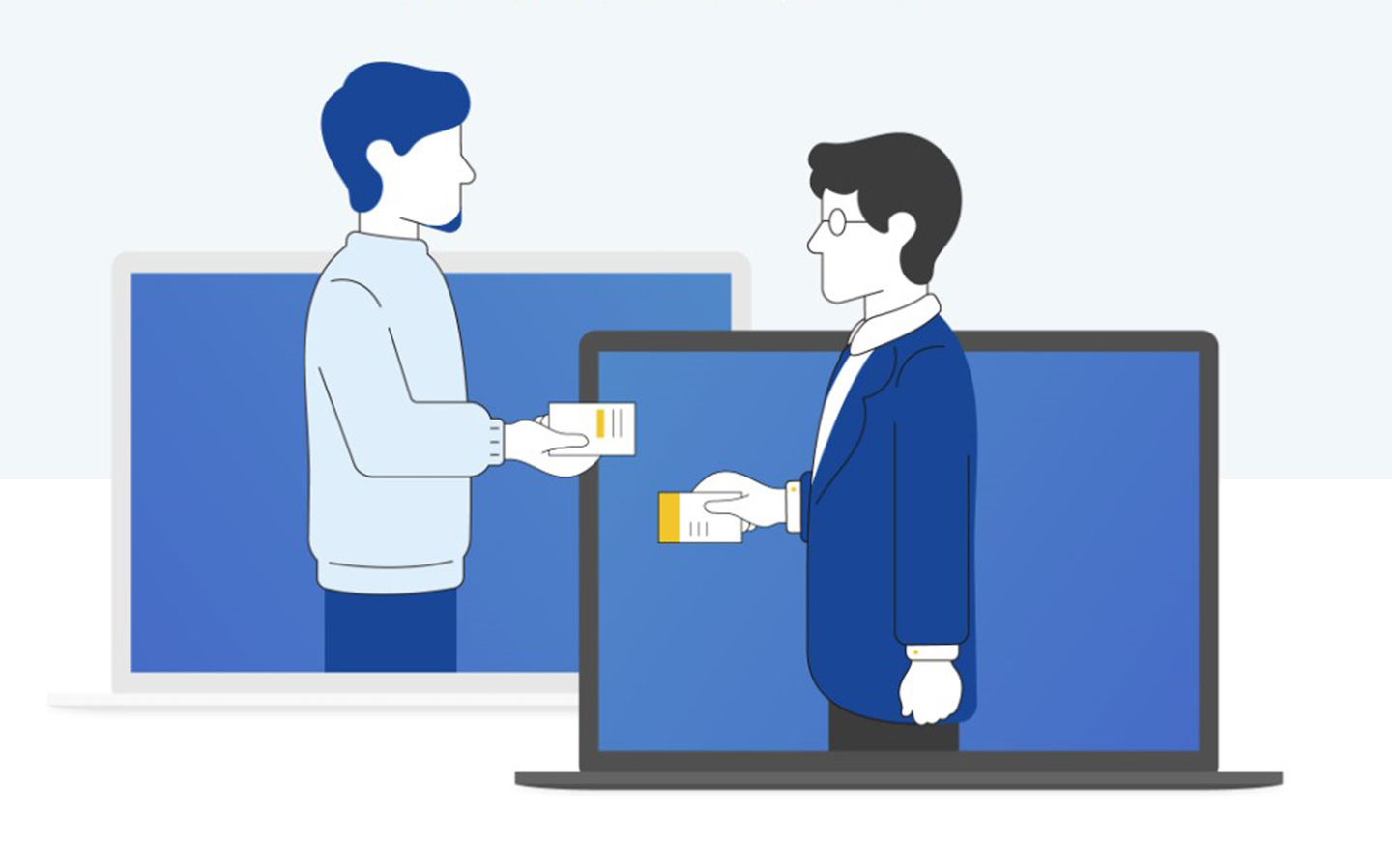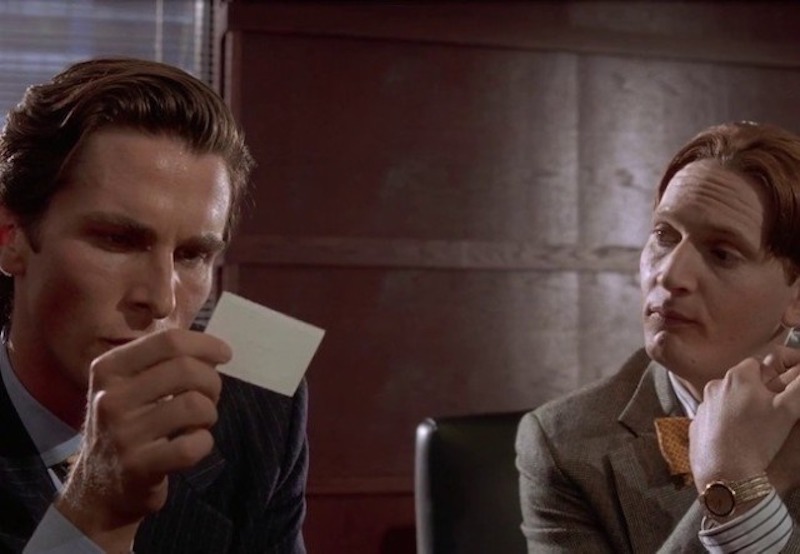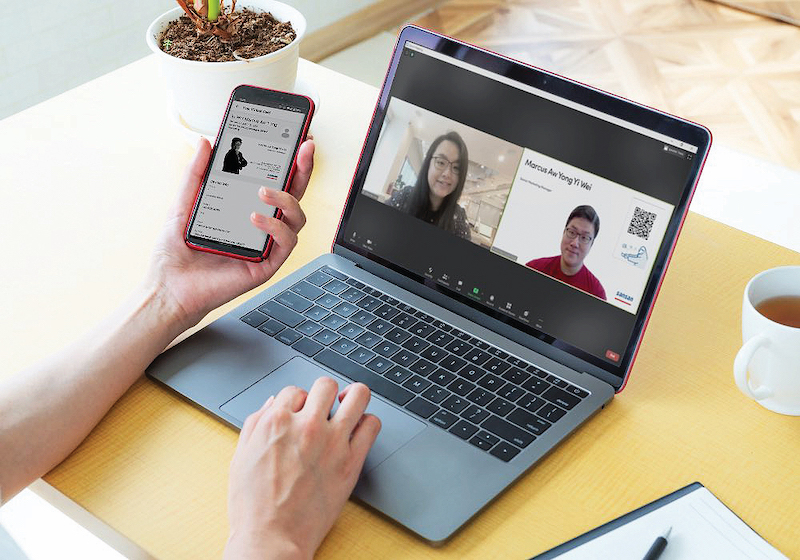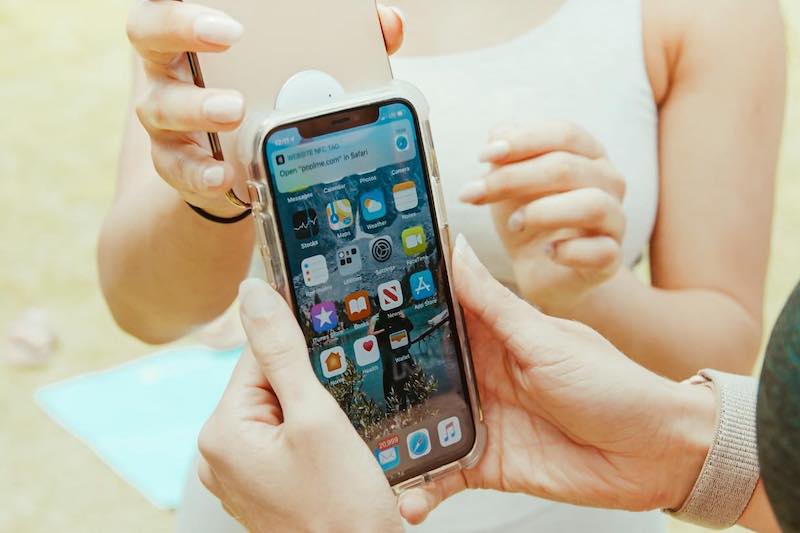
Swapping business cards is as close to a universal custom as you can find in the corporate world (Photo: Sansan)
A business card is an extension of yourself, even if you are a Wall Street investment banker who commits frenzied murders in your spare time. We are referring to a piece of fiction, of course — the black comedy horror satire American Psycho, in which Christian Bale plays a suavely solipsistic Patrick Bateman.
“That’s bone,” he describes the colour of his newly printed card, while trying to impress his fellow materially wealthy but culturally bankrupt executives. “And the lettering is something called Silian Rail.”
The scene is strikingly iconic because the status-obsessed Bateman is immediately crestfallen when the other men all whip out equally fancy ones. This segues into a showdown of male ego as they flaunt their expensively made, yet largely indistinguishable, cards. While most viewed this pop-culture moment as an utter display of absurd masculine competition, printing presses around the world saw it as an aha moment that sparked more creative approaches to their craft. Ultimately, a humble business card can reveal a lot about yourself, more than you think.
american_psycho_business_card.jpeg

This cornerstone of business stationery, which we casually stuff in our pockets and hardly consider more than its face value, has existed for a long time in one manner or another. Calling cards were invented in China in the 15th century to announce the impending arrival of a guest. English merchants used them as miniature advertisements in the 17th century. In present-day Japan, the ritual of exchanging cards called 名刺交換 (meishi-koukan) is as strict as a tea ceremony. Rather than just a gesture of courtesy, it must be performed before any formal discussions take place.
Swapping business cards is as close to a universal custom as you can find in the corporate world. But with more people exchanging social media handles than handshakes these days, is the longstanding business etiquette truly off the cards?
As we shift towards a world of digital goods and virtual interfaces, the DNA of a tactile business card is quickly unravelling. Augmented reality (AR) tags are emblazoned on cards so that 3D objects — either the face of the employee or the products being promoted — emerge when viewed with an app. In China, the practice of card swapping is almost obsolete as business people now scan each other’s QR codes, directing one to the profile of their WeChat app, which can also be used to book hotels and transfer money. Professional social network service LinkedIn makes it easier to share contacts in person using Bluetooth while newer sites like HiHello and Contxts allow users to create virtual business cards.
The pandemic has opened as many doors as it has closed. Team meetings and industry conventions can be held globally anytime, but face-to-face networking has been reduced to a social exchange over a screen with a fake background of our dream vacation. As white-collar workers flee to their home offices, global printing companies are suffering a setback — Dutch e-commerce Vistaprint admitted that its sales plummeted by 70% earlier this year and have yet to recover fully. A post-pandemic scenario does not seem promising either. Is it safe to hand out cards to potential clients? How do we sanitise them? What would the well-mannered Japanese think?
sansan.jpeg

Contrary to tradition, “It’s time to change people’s mind,” says Sansan Global Pte Ltd regional CEO Edward Senju, who was born to Japanese parents but raised in Mexico. Unicorn tech start-up Sansan (whose name is a play on the honorific Mr or Ms in Japanese) creates broader digital infrastructure to completely utilise connections companies make. Founded by Chikahiro Terada, Sansan has devised a hybrid system that digitises physical business cards with a scanner or a mobile app. Your contact data will be uploaded securely to a cloud database, and it becomes a permanent resource that can be shared internally with colleagues. In addition to capturing basic contact information that can be integrated with more online platforms such as Microsoft Teams and Google Calendar, the Sansan app logs a contact’s hobbies and even preferences that may be used to strengthen future relationships.
Although clients are no longer getting the physical business cards that they can scan and add to the system in this social-distancing age, Sansan has adapted and launched virtual versions mid-last year. More than 4,300 companies have subscribed to its QR-code based system, which can be conveniently placed next to your face during a video call. Your recipient only needs to scan the code on your screen for the details to appear.
Gen Z are already helping C-suite managers close more deals than anticipate prospective leads. Los Angeles-based start-up Popl, conceived right before the pandemic, has been leveraging Tik Tok users to promote its modern-day business-card alternative. Instead of a scanner, the Popl device is a near-field communication (NFC)-enabled hardware tag that sticks to your phone to make contact-sharing as seamless as using Apple Pay or AirDrop. According to co-founder and CEO Jason Alvarez-Cohen, a UCLA graduate with a background in computer science, Popl has sold over 700,000 units and generated US$2.7 million in sales for its digital business card technology.
newswired_main_pic.jpeg

Like Popl, there are more inventors out there who think they have the solution of transforming the traditional business card model pegged. TouchBase Technologies, which makes paper cards with “conductive ink” that stores another person’s information by tapping it on a device, maintains the presence of an actual card while using current touchscreen technologies. There are other affordable wireless exchange apps too that do not require you to purchase a phone that can read NFC tags, such as the scanning feature in Evernote (it costs US$45 a year for unlimited scanning) and CamCard (free for a limited number of scans) but they do not exactly provide customer insights or function beyond recording your professional encounters.
Even though a digital revolution forecasted the paperless office, the rotary card file — the best known is by leading brand Rolodex — is a trophy case to display one’s connectedness and size of business network for the world to see. If Steve Carell’s on-screen persona Michael Scott in The Office taught us anything, it is that the physical business card has a logistical advantage as it is much easier to press paper to palm because not everyone is equipped with the same funky applications that will invariably send an email on the spot to share their details.
Technology has reimagined the (rotary) wheel by bridging analogue and digital but new-age innovations usually come at a hefty price. Even if you cannot afford luxury stationery (again, the colour is not white, but “bone”), offering a physical card with both hands earnestly is a no-cost strategy that will still make a lasting first impression.
This article first appeared on Nov 1, 2021 in The Edge Malaysia.


